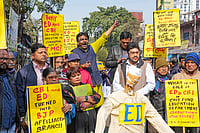The way companies engage with guests is being revolutionized still. At a point when digital metamorphosis seems to be the trend, a new frontier awaits that will review fidelity's performing Web3. For airlines and global brands, this is n't just a technology shift; it's a makeover of client connections, trust, and extended commerce.
The Problem with Traditional fidelity Programs
fidelity programs have been a chief of marketing strategies for decades. Cash back, acquiring points, or accumulating long hauls is commodity that shoppers are well apprehensive of. But times agone , utmost of these kinds of programs started losing their charm. What tends to do is that the client finds himself or herself stuck in unrestricted- off systems with prices that are tricky to redeem, deadline- compartmented expiration on points, and factual worth getting decreasingly fugitive.
The core issue is one of power and freedom. Traditionally, points or long hauls live on personal databases that belong entirely to the brand. Consumers earn them but do not actually own them.However, there is not important anyone can do about it, If an airline changes its geste or a trafficker alters its redemption rules. This imbalance has created mounting wrathfulness, especially among youngish consumers who want further openness, agency, and personalization.
Enter Web3 Upside Down Power Dynamics
Web3 ushers in a revolutionary change in that it decentralizes power. rather of depending on brands to be doorkeepers, Web3 fidelity programs take advantage of decentralized networks that allow consumers to truly enjoy their prices. Power is decoded in tamper- evidence digital checks that give both translucency and security. guests no longer sweat losing their hard- earned prices due to policy changes or platform closures.
This shift allows consumers to manage, trade, or indeed league their prices across platforms and brands. Imagine this a rubberneck can trade long hauls from one airline to unlock hostel abatements, shopping at retail stores, or unique gests offered by a range of mate brands without the traditional constraints that now dominate.
Creating Emotional Value Beyond Points
What's further intriguing about Web3 fidelity programs, still, is n't only the transfer of power but also the emotional resonance that follows with it. Rather than being unresistant donors in a destined system, guests come active members of a community. Brands can design gests far beyond transactional value.
For case, airlines may offer exceptional trip gests , field tenures behind the scenes, or exclusive couches that can only be reached by getting a member of the fidelity community. Fashion companies can offer early look access to fresh collections or special- edition collaborations. These prices are better than abatements and promote a stronger sense of belonging and identity.
Data sequestration and Personalization Without concession
One of the most delicate aspects of client fidelity is information. The aged systems have a tendency to make guests give up huge quantities of particular data, which companies vend off. It has instigated enterprises about sequestration and data security.
Web3 presents a different model. rather of brands holding client information, guests enjoy and control their own data. authorization- grounded data sharing provides guests with the option to set what data they would like to partake in exchange for specific offers or impulses. Not only does it insure better sequestration, but it also enables better personalization. When guests willingly submit accurate, applicable data, brands can draft gests that are genuine reflections of individual preferences.
Cross-Brand Collaboration and Arising Ecosystems
maybe the most groundbreaking aspect of Web3 fidelity is the power it has to produce connected ecosystems. Traditionally, fidelity programs stand alone; a person's airline long hauls are separate from their hostel points or their price program with their neighborhood coffee shop. Web3 can bring these disconnected touchpoints together, creating an intertwined experience that reflects the client's entire life.
These types of ecosystems foster collaboration rather than competition. A hostel chain, an airline, and a life brand can live together in harmony, participating collective advantages that enhance the collaborative client experience. The network effect transcends kindling lesser fidelity and adding new business openings that were n't possible under stage-alone systems.
Challenges Ahead Adoption, Education, and Trust
While it has tremendous eventuality, Web3- grounded fidelity is still in its immaturity. The technology on which it's grounded is n't well understood by utmost consumers, and some may indeed be put off by its ramification. Brands must strive to make stoner gests simpler, hiding the specialized layers before simple interfaces that are incontinently accessible and simple to navigate.
Education will play its part as well. Mass relinquishment of Web3 fidelity programs will bear consumers to understand the value, but it can not be overwhelmed by the mechanics. Trust will be crucial, especially because mass cult are still cautious of utmost new tech.
A unborn erected on True fidelity
Web3 fidelity programmes are further than a new marketing ploy; they represent a abecedarian change in how brands and guests interact. Through the immolation of true power, lesser inflexibility, and real personalisation, airlines and global brands can transfigure how they reconnect with guests on an emotional position.
fidelity in this new world is no longer about points accumulated in an account but about gests , choices, and genuine connections. As Web3 continues to develop, those brands that embrace its full eventuality may find that they are n't only retaining guests, but erecting communities that endorse for them in a way former models could not.

























